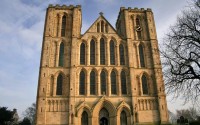A Very Dangerous Work’: Sir Gilbert Scott and the Restoration of Ripon Cathedral
- Date
- 15 Dec 2015
- Start time
- 7:30 PM
- Venue
- Tempest Anderson Hall
- Speaker
- David Winpenny

David Winpenny
Sir George Gilbert Scott was the most famous and most prolific architect of the 19th century. Perhaps best known today for the Albert Memorial and the Midland Hotel at St Pancras, Scott was celebrated in his day as a designer of churches and a restorer of cathedrals.
Scotts career is outlined in this talk, from his early days as a designer of workhouses, through his awakening to Gothic architecture by reading Pugin, to his knighthood and his burial in Westminster Abbey. It details his spat with Lord Palmerston over his designs for the Foreign Office, and looks at a neglected aspect of his work, his country houses.
Taking Ripon Cathedral as an example, it also looks at his cathedral restoration work which attracted criticism later in his career, notably from William Morris, as the philosophical basis for such work shifted. Scotts Ripon restoration shows how his intervention could be sensitive and careful (and vital to stop imminent collapse) but was also occasionally cavalier. It is certainly due to his work that Ripon and at least 25 other British cathedrals are still standing.
Member’s report
Gilbert Scott (1811-1878) was a virtually self-taught architect. His enthusiasm for the subject was awakened in his childhood years on many visits to local churches and he became one of the most prolific architects ever produced in this country. The burgeoning railway system made it possible to travel great distances and he was commissioned to design or alter around a thousand buildings in forty years. Specialising first in workhouses, the eventual scope of his work encompassed institutions, churches, large houses, hospitals, government (eg the Foreign Office) and memorials (eg the Albert), but cathedrals and churches represented the backbone of his career. He had a passion for spires.
One of his greatest challenges and achievements was the restoration and redesign of Ripon Cathedral, which was in such a state that some of the wall cracks were a foot wide. Begun in 1862, the whole project cost £40,000, around a million pounds in todays money.
Many of Scotts designs were controversial at the time and Victorian restorations generally are often considered rather cavalier, but David Winpenny pointed out that the Victorians deserve our thanks for saving so many buildings that would otherwise have been lost. Ripon is a notable example.
This lecture was brought to life by many excellent before and after illustrations and photographs.
Ken Hutson